Batman: Examining the Introduction of The Batman as Three-Act Gothic Horror
Tim Burton’s stylized 1989 Batman film was responsible for bringing the masked vigilante back onto the movie screen in a more serious light than Adam West’s comedic portrayal of the caped crusader. He brought many interesting elements to the introduction of The Batman, which I would like to examine in detail.
Much like the overall structured arc of the film, the introduction of The Batman is done in a three-act structure. As this is a fairly lengthy sequence, I will separate the sequence into its three logical components.
There are a few themes which should be pointed out before we delve into shot analysis:
- Expectation/Subversion. What we see may be misleading.
- Gothic Horror. Even though we don’t encounter him until the “third act”, gothic horror is a prevailing theme of this sequence.
- Canted shots. Partly visual homage to the Adam West Batman series, partly subtle inference.
- Voyeurism. Certain elements of the visual framework rely heavily on an element of voyeurism in order to raise the level of suspense.
Act One: The Setup
After the iconic logo sequence, we fade up on a wide skyline of “Gotham City” …
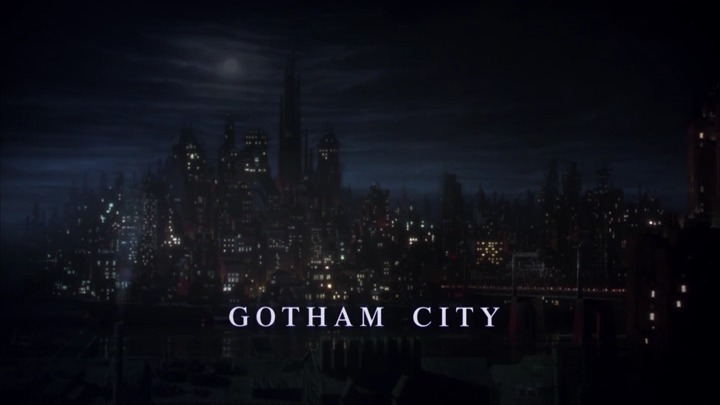
… and continue with another (slightly less wide) crane-level view of a busy street, ostensibly somewhere in Gotham. It’s set up with single-point composition/perspective – we know something’s not right about this scene, even though we don’t know anything about the characters and scenery we’re seeing.
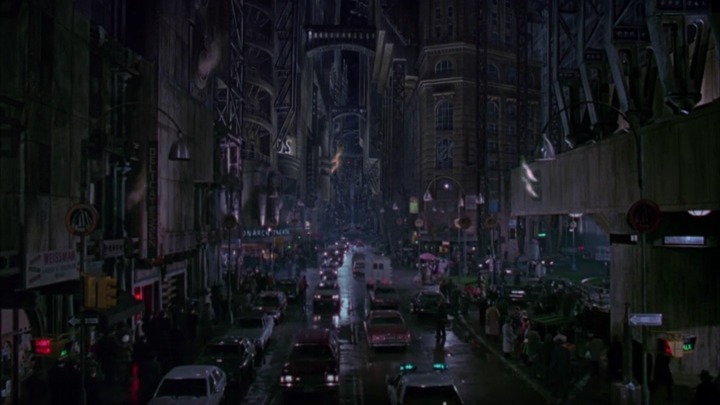
We move into a left-to-right dolly shot, with multiple moving layers:
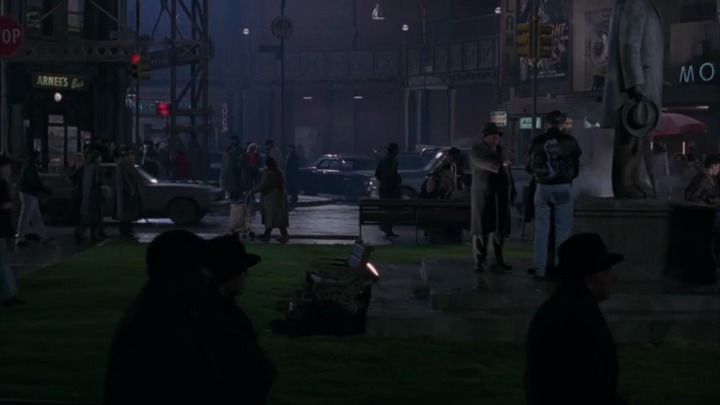
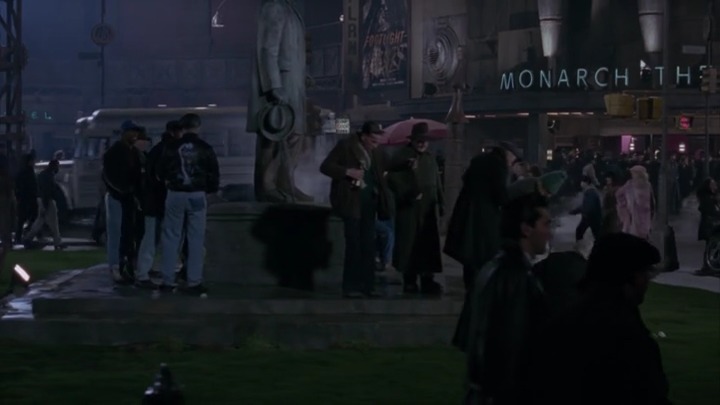
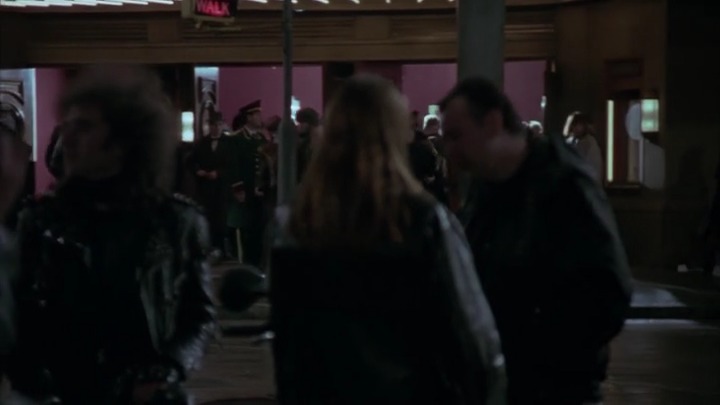
The depth of field used is large enough that, even though we can see almost everything clearly, we have no idea what the subjects of interest are. All of the layers appear to have motion in them, from the out of focus elements in the foreground to the grouping of people in the green to the pedestrians walking in the background. The shot has conveyed a sense of scale ; even though this wasn’t shot in a “real” city like the Nolan Batman trilogy, we can believe this set is an actual busy city.
Now, shifting to the sidewalk, our subjects begin to become apparent. Burton intentionally obscures them behind other members of the crowd, making the viewer into a voyeur – trying desperately to see our subjects through a sea of other characters, as they try in vain to hail a cab.
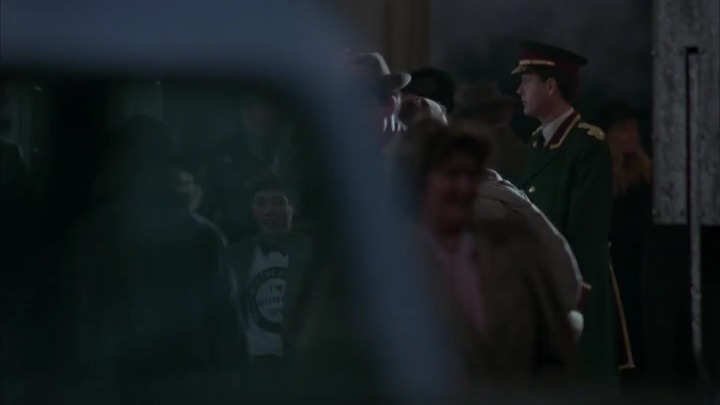
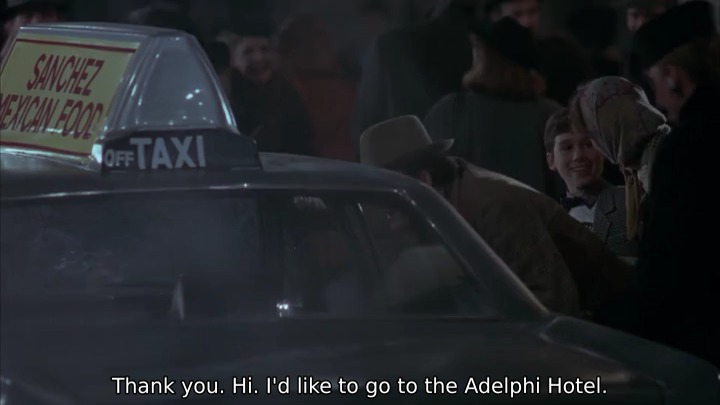

Burton shifts to a longer shot from across the busy street, and we watch our protagonists attempt to cross. Notice that they are barely visible in the gaps between the characters in the foreground.
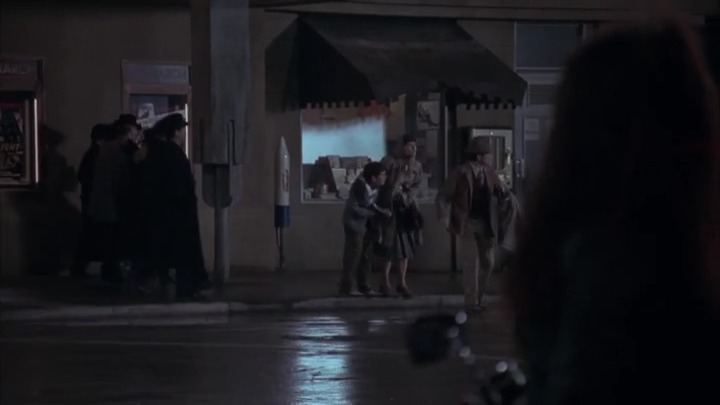
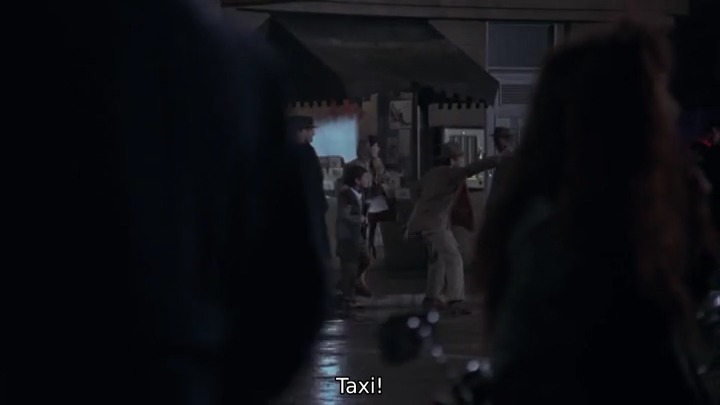
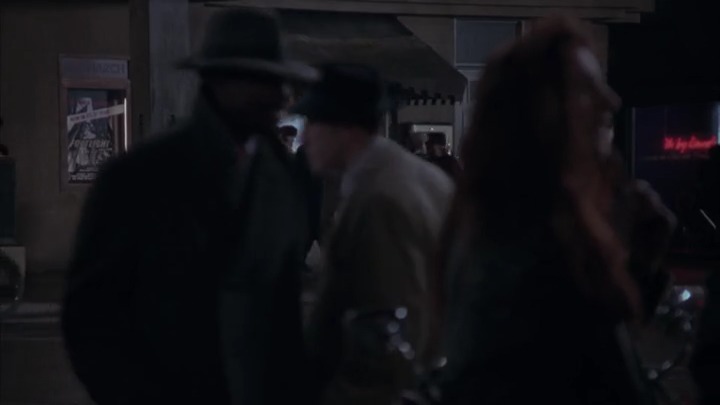
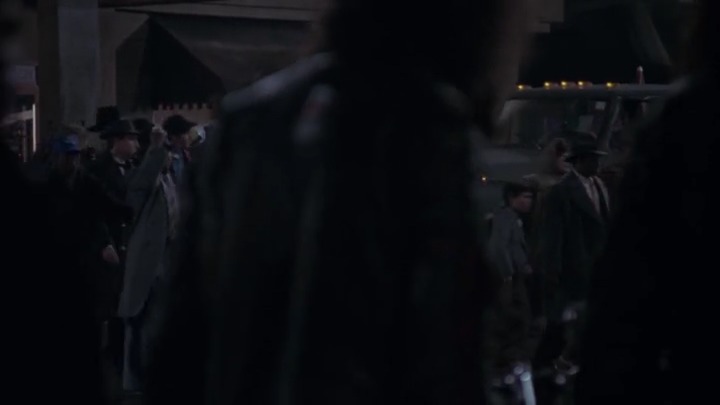
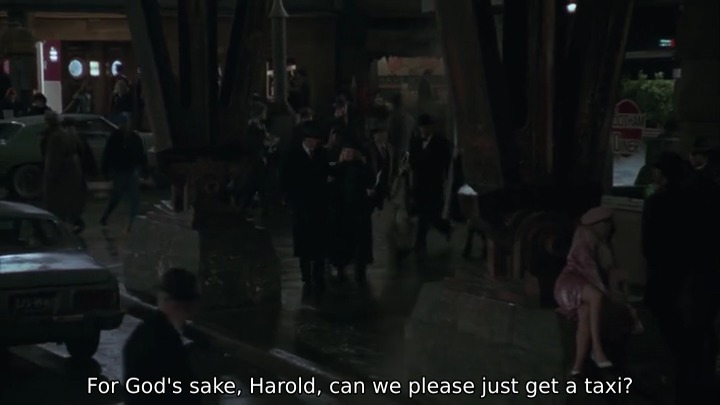
We shift to a closer view, and our protagonists are shifted into mid-stage, living near the equatorial mark of the frame.
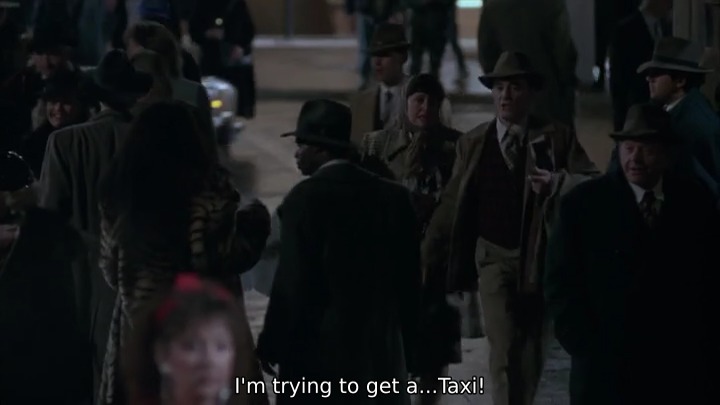
Notice the introduction of a single element of vivid color:
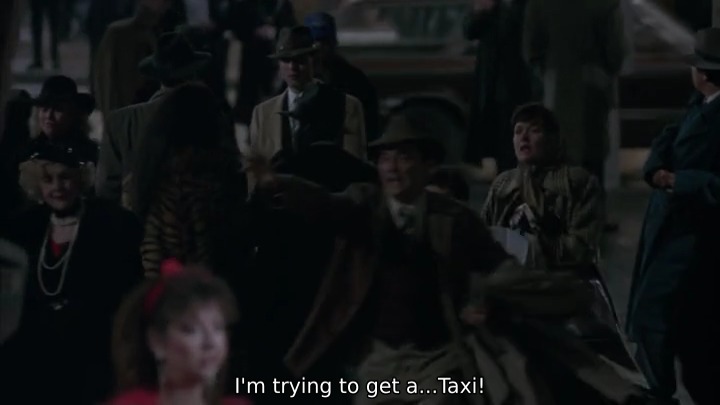


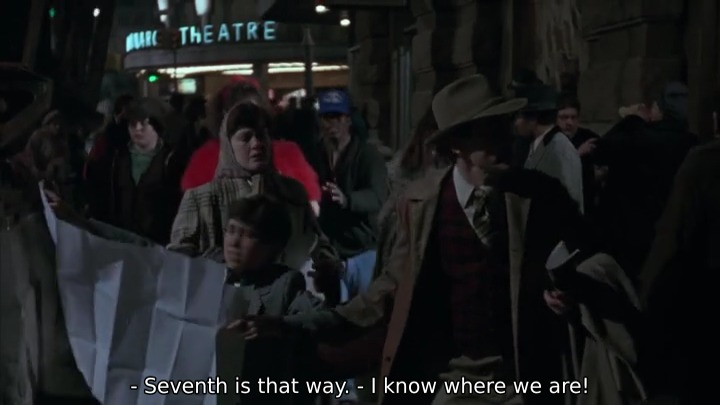
But it’s a red herring. The streetwalker is there to indicate the presence of a seedy element, as we assume that they would inhabit less affluent neighborhoods – but she isn’t of immediate importance. Burton lingers on her after the protagonists have left the frame, for just a moment. Now she is occupying the center frame.
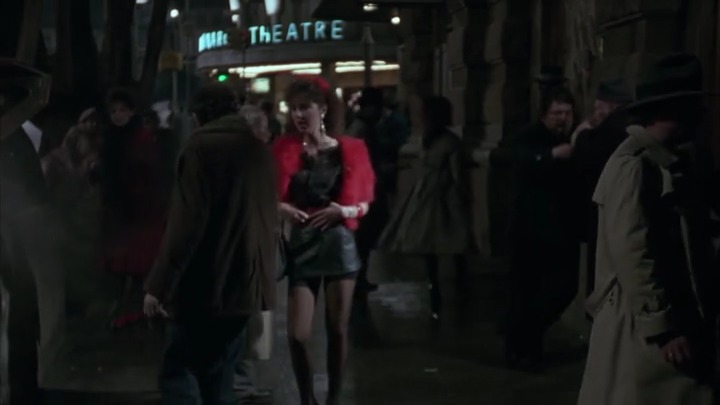
As our protagonists become completely lost, we see the elements of the Batman city which will be reused time and time again in this film: stark light and shadow, and fog.
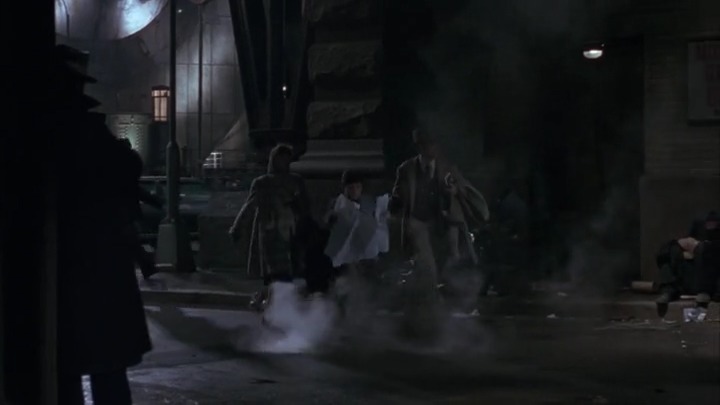
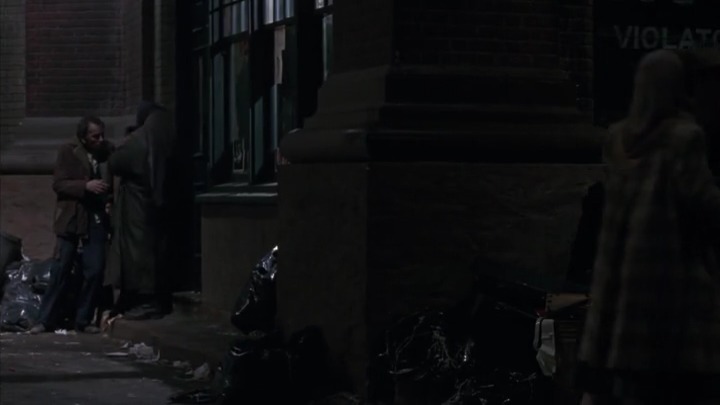
Notice that we linger, again; this time, on an image of garbage and bums, as the family exits our frame.
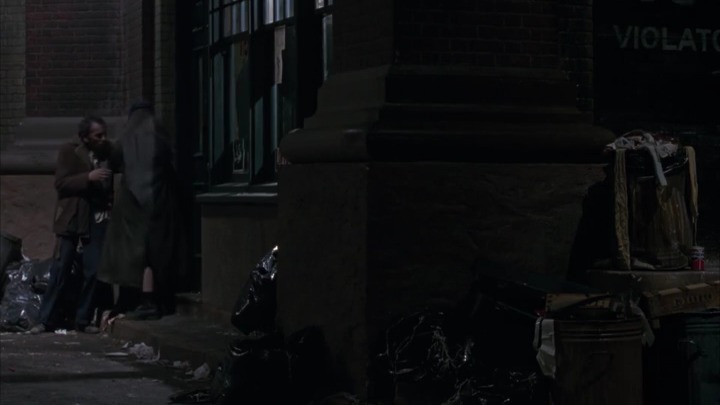
The first of many dutch angles is presented through a very voyeuristic view from several stories in the air. Whose point of view is this?

The family breaks into the frame to head towards yet another street denizen:
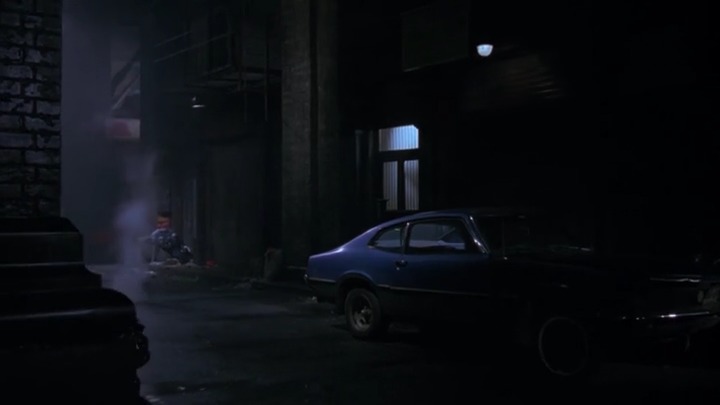
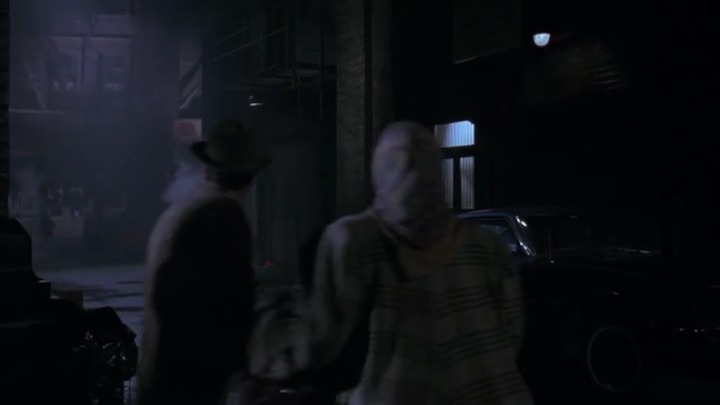
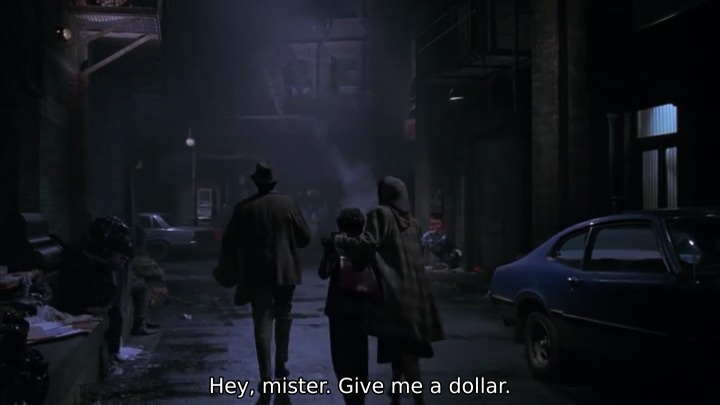
We flip around to see them coming, mainly so we can see the bum asking for a dollar.
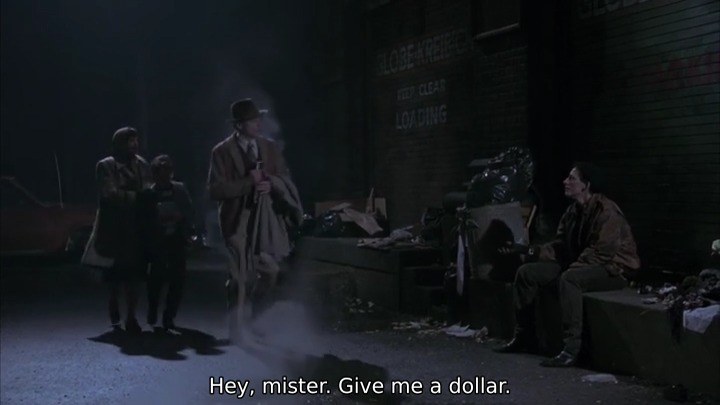
Then we get a medium shot of the bum standing – and linger there for a second. He’s important, but we don’t know why.
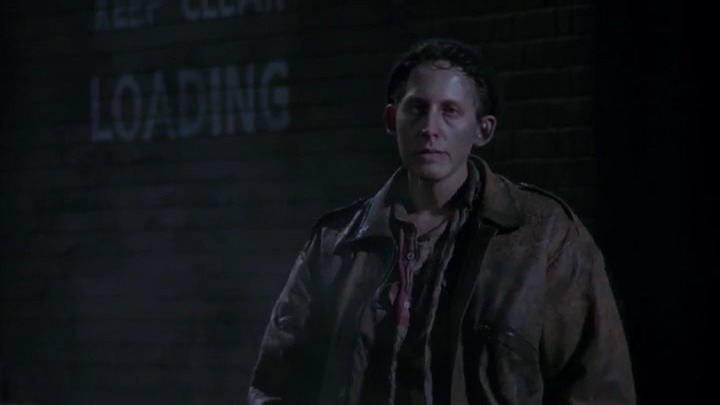
The scene is set.
Act Two: The Crime
We’re given a very awkward shot of the back of the father’s head as he comes around the corner …
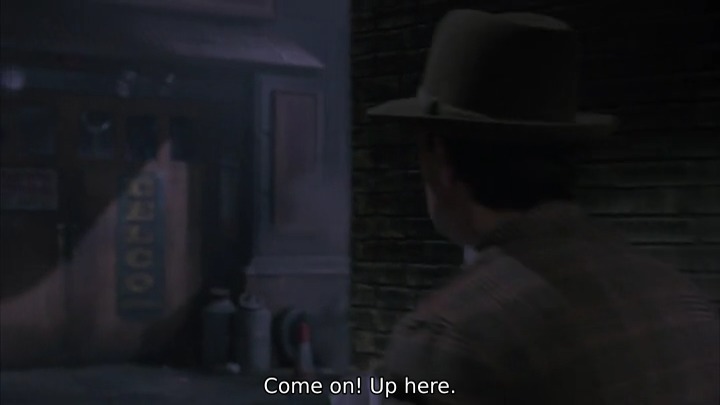
… but only so we can set up a shot of a thief cracking him in the back to incapacitate him.

We reverse the shot, and the perpetrator – or at least, the gun of the perpetrator – penetrates the lower left of the frame. Instead of just showing a reaction shot of the mother and son, the safety of the frame is incrementally invaded by the perpetrator.
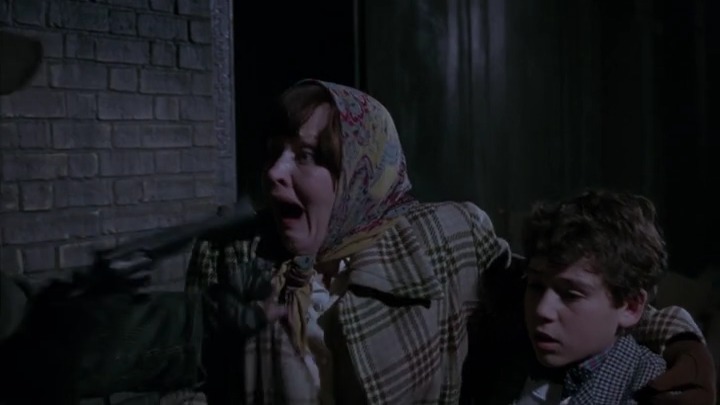

Switch to a reverse dutch angle of the gunman with the father lying prone in the background. This composition both allows us to see what the mother and son can see, allows us a better vantage point of the perpetrators (now that we can see that there are two of them), and gives us the uneasiness of the off-kilter composition.
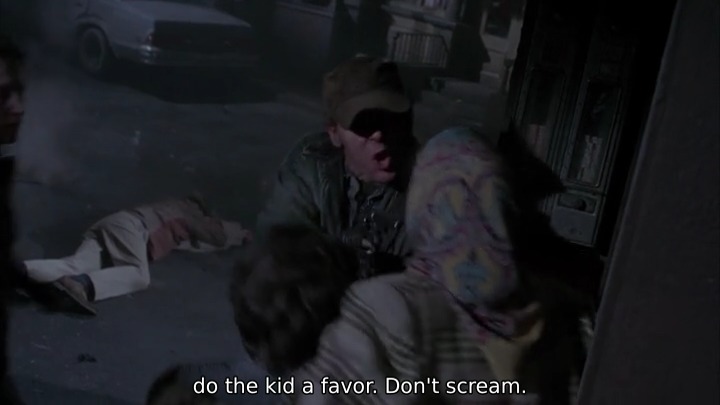

Back to the view of the mother and son, with the perpetrator removed. They are all alone, visibly as well as physically.

We switch to the high vantage point shot so that we can see that there is no one around – but who is watching?
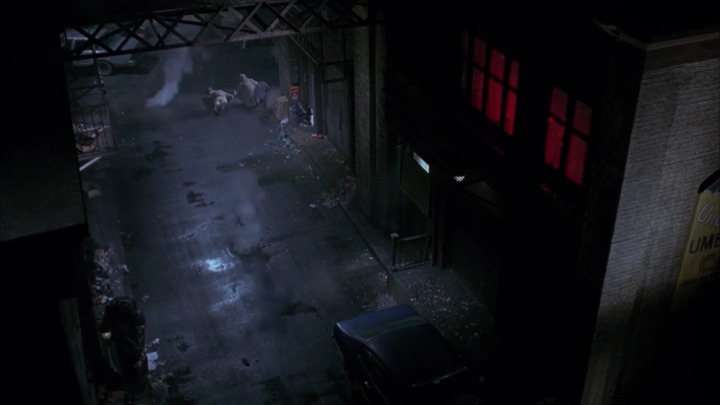
Who is watching?
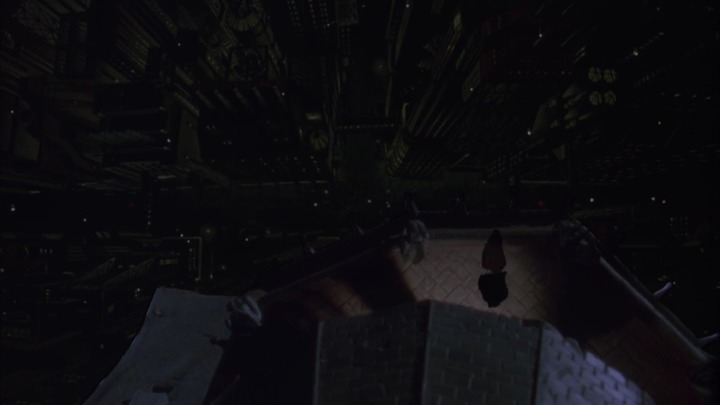
The Batman, that’s who. But we don’t get to see him yet – he is still a function of the shadows and fog.
Act Three: Retribution, or Enter The Bat
The thieves are celebrating on the roof. We set up with an odd off-angle shot from above…
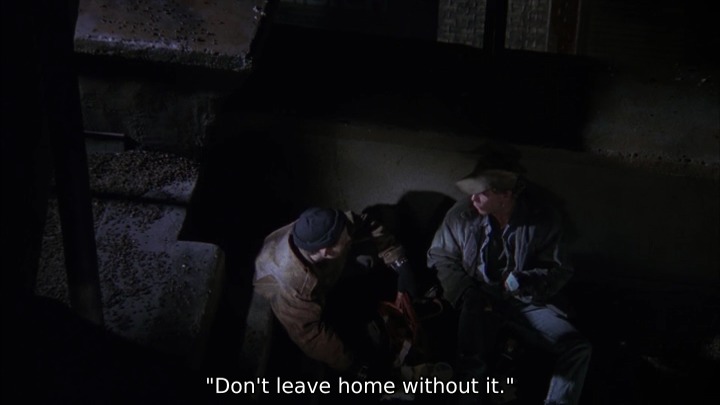
… switching into a two-shot for some shot / reverse-shot rhythm. One of the men is the gunmen, and the other is revealed to be the bum who had asked the family for money.

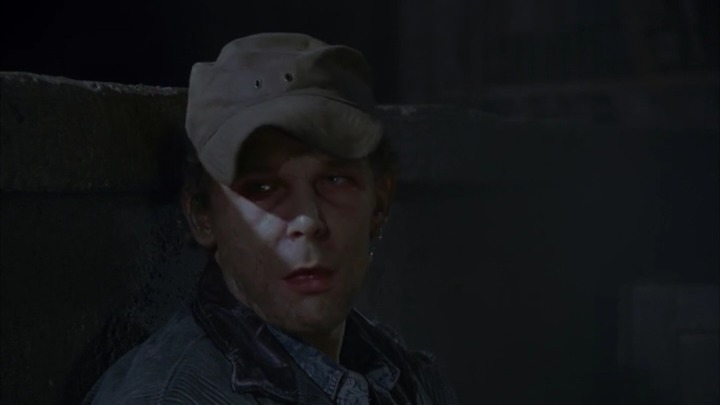
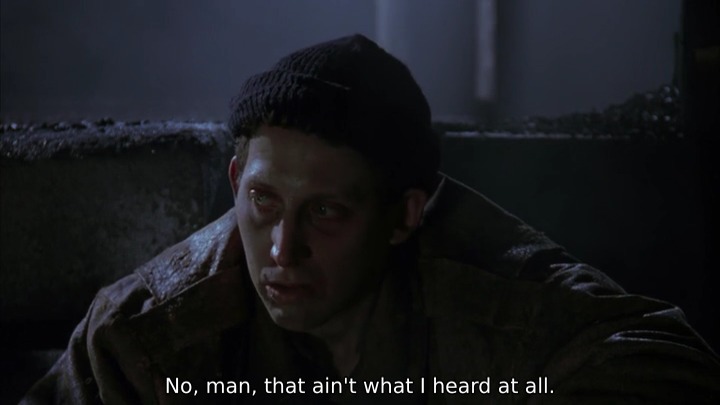
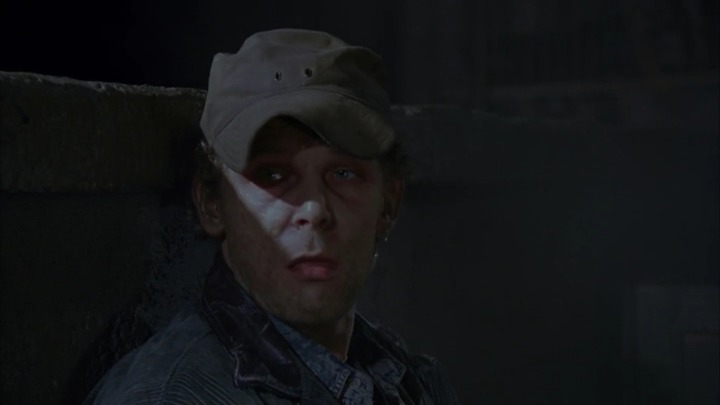
This is where the familiar ends. Burton backs up and shows us the wide shot, which is canted – slightly. There’s some fog in the upper negative space in the frame …
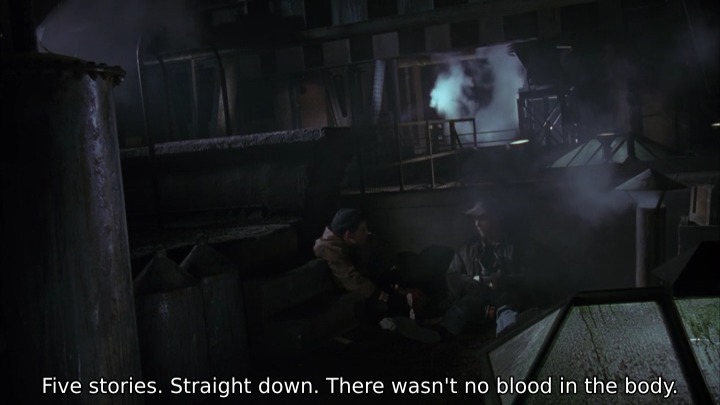
… but wait …
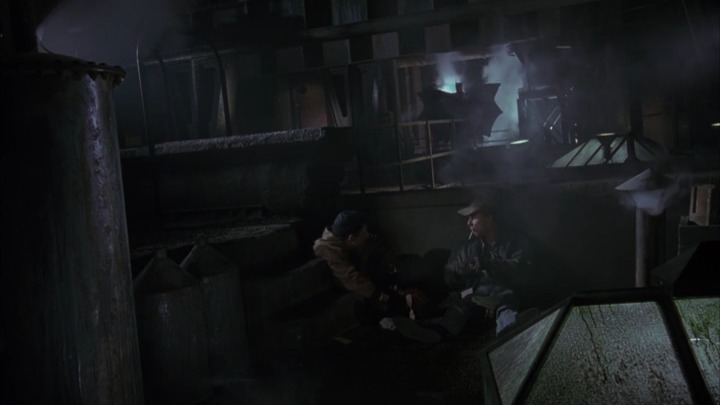
… now The Batman is there. Like any villain in a horror film, the “victims” (as the perpetrators from the previous act are about to become the victims in this one) are completely unaware of the silent danger which is behind them.

See, there ain’t no Bat. So, we have nothing to worry about. Now we flip to a point-of-view shot from above:
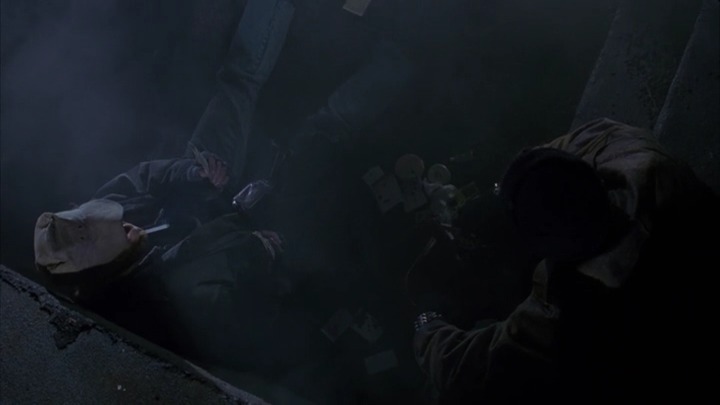
Whose point of view could this be?
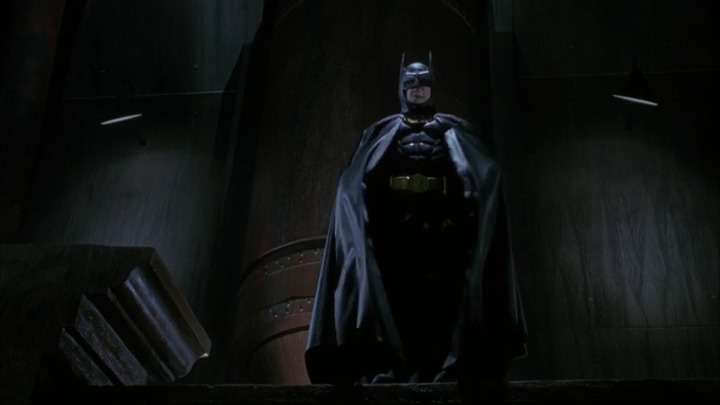
That’s right. His point of view. The thieves scatter in the reverse view.
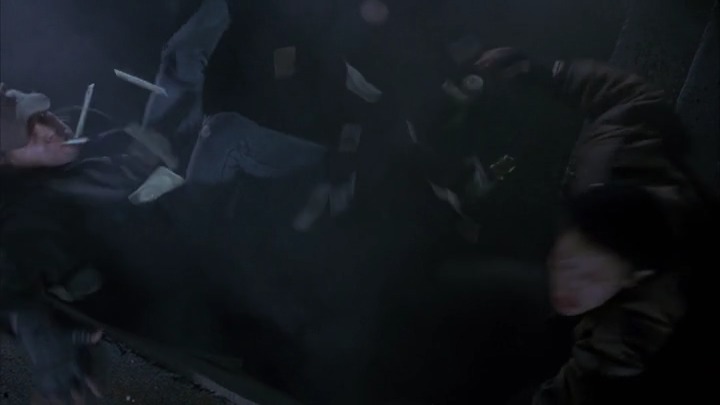
Reverse, and The Batman drops into the space below the frame, ostensibly the space which the thieves have just vacated.
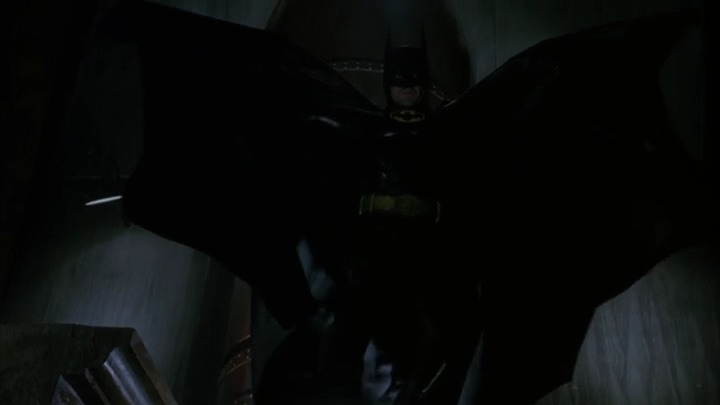
We flip around so that we can see the thieves running away from The Batman. Burton positions the camera above eye level, so we’re looking down on the scene slightly.

The Batman sits on the right-most third as the thieves empty their gun’s bullets into him. There is still a slight cant present in the shot, even if it’s not immediately consciously perceptible.
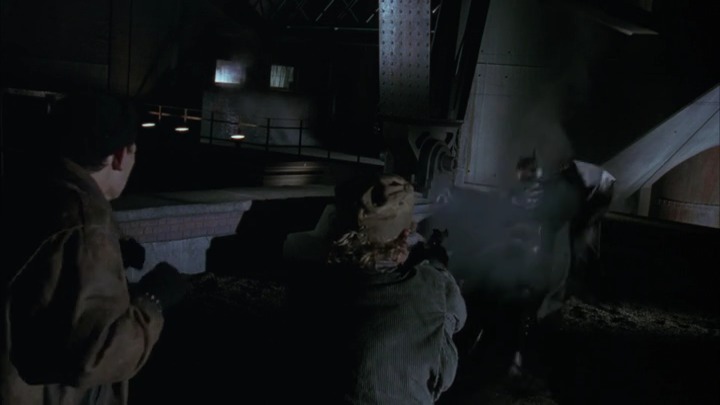
We move the camera vantage to ground level so that we can effectively look up on a relatively prone and defeated Batman.
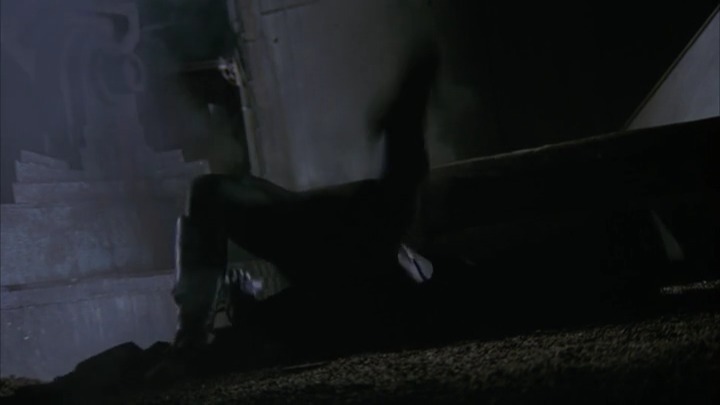
Reverse to see the thieves beat a hasty retreat …
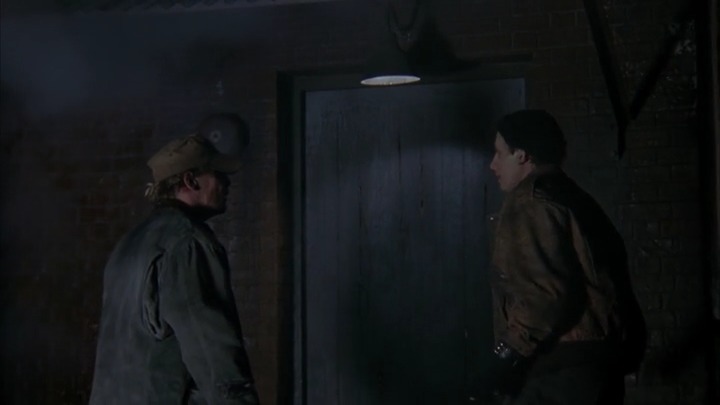
… but, as in any horror film, you want to see what was chasing you. And what could the harm be? You just shot him dead, right? The thieves look back over their shoulders.
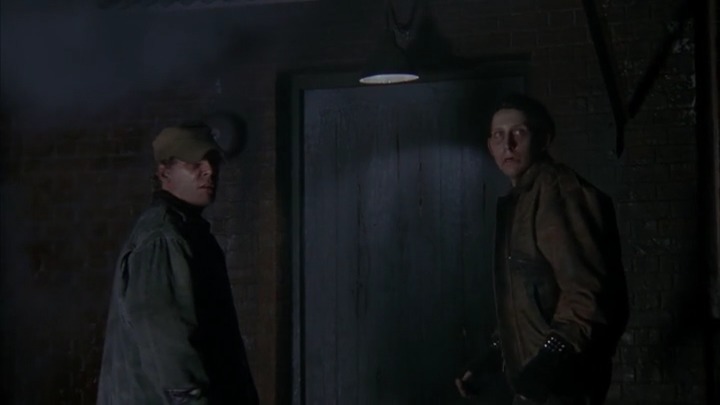
Now, we see the full gothic horror element. Surrounded by fog (which, I might add, was not there in any of the previous shots), The Batman rises like the unkillable monster of many horror films – eclipsing the mere mortal who dared to try to kill him:

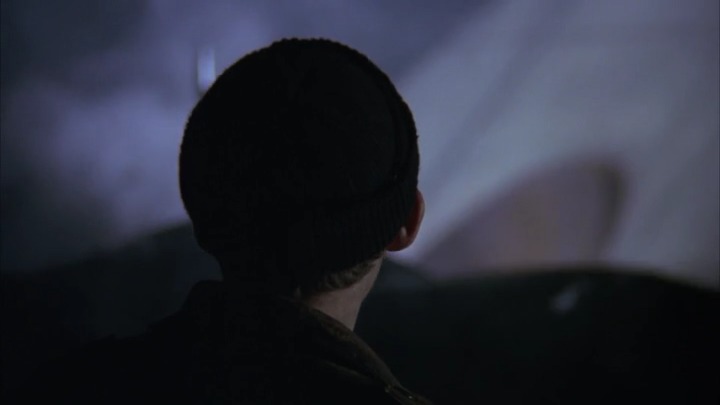
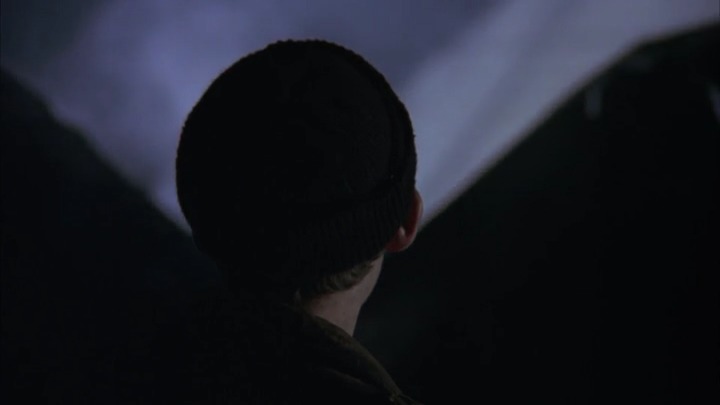
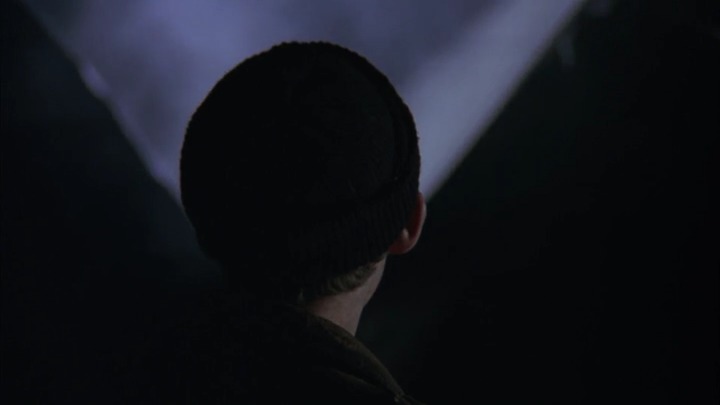
Reverse for relatively close-up reaction shots from the thieves. We have to get into their heads to absorb the full impact of what they’ve seen.
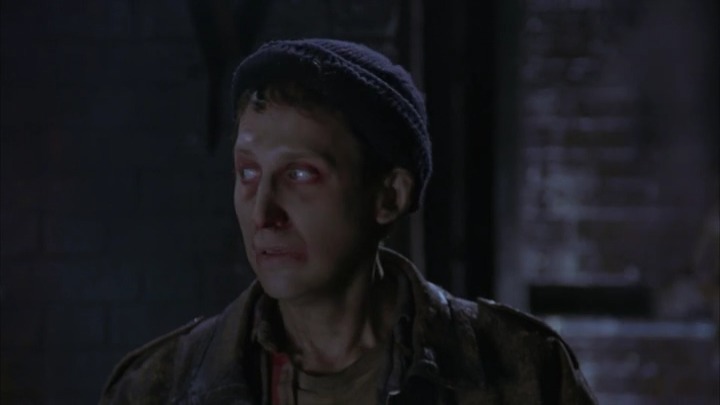
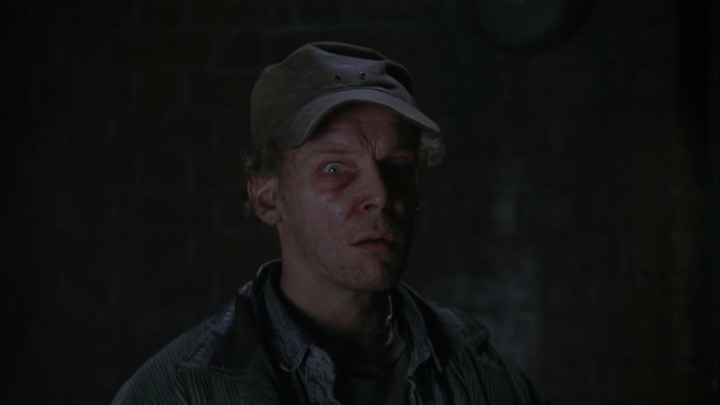
Back to The Batman. He’s standing fully – just standing there, occupying the negative space in the center of the frame. His mere presence is pushing them out of the diegetic space of the frame.
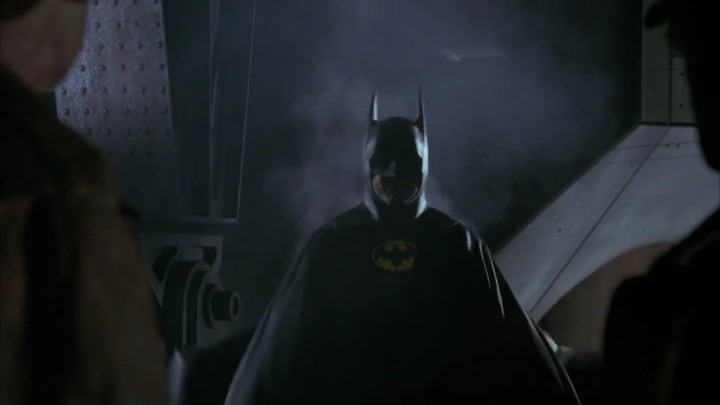
We reverse to the bum we first saw …

… but only so we know who The Batman is about to kick …
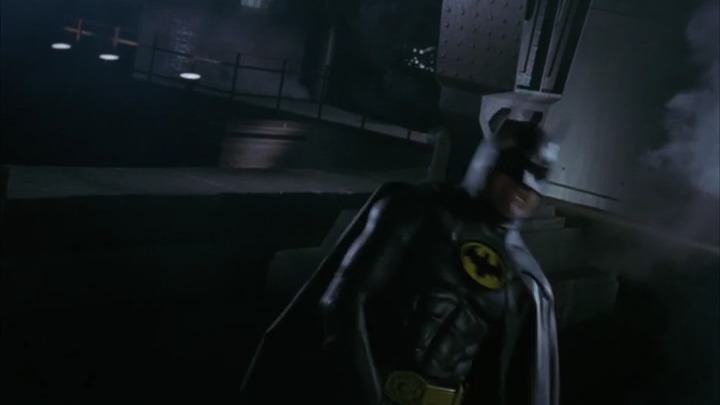
… through a door.
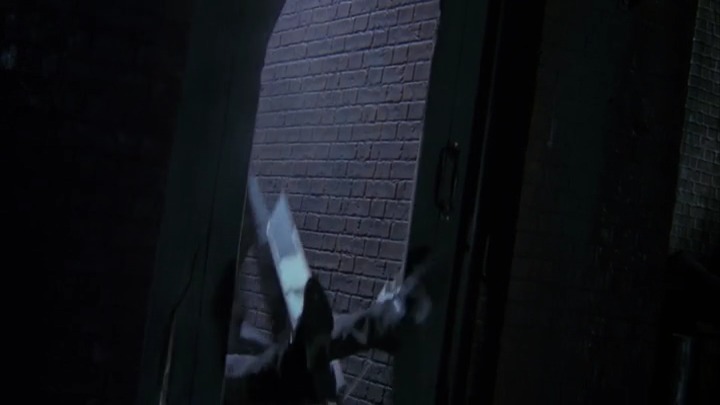
A canted view of the remaining thief …
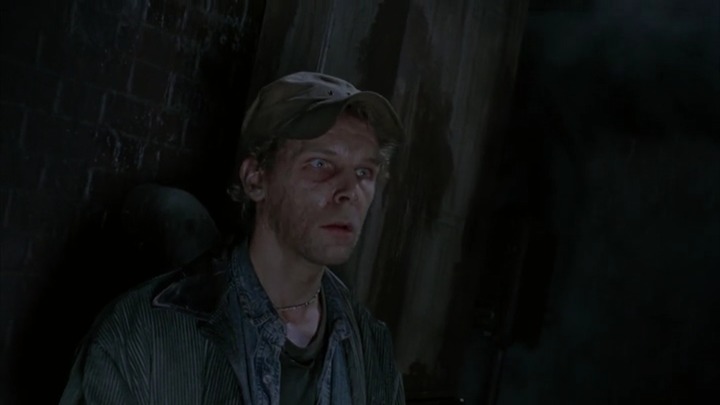
… followed by an extreme close-up on Batman’s hook and line. Like an old-west cowboy in a spaghetti western, he’s about to rope a villain.
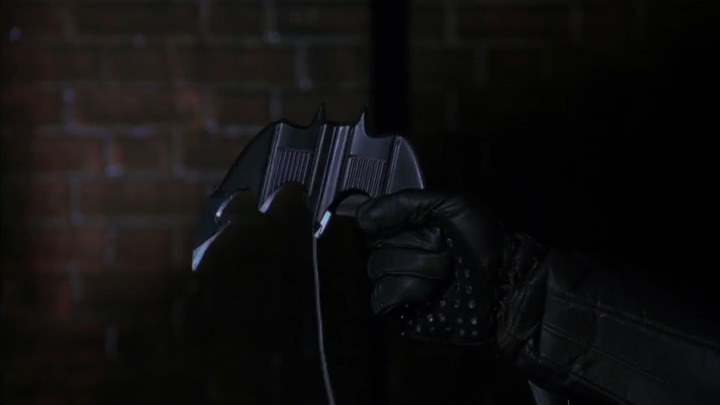
We cut to the thief running, and then being tripped by the Batman’s arsenal.
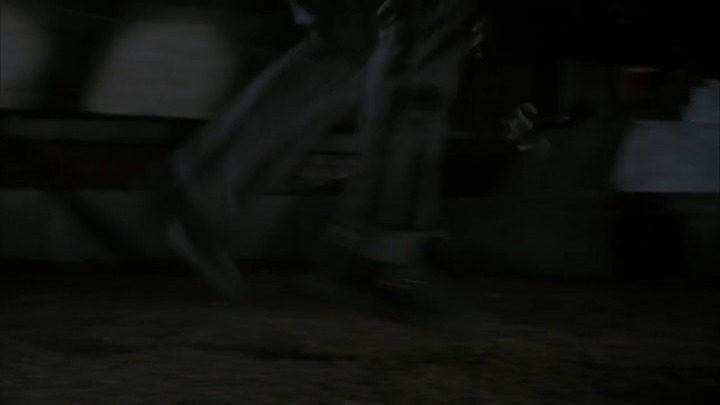
Cut to a wider view. The action is happening on the diagonal axis, with The Batman cloaked in darkness, surrounded by jets of fog.

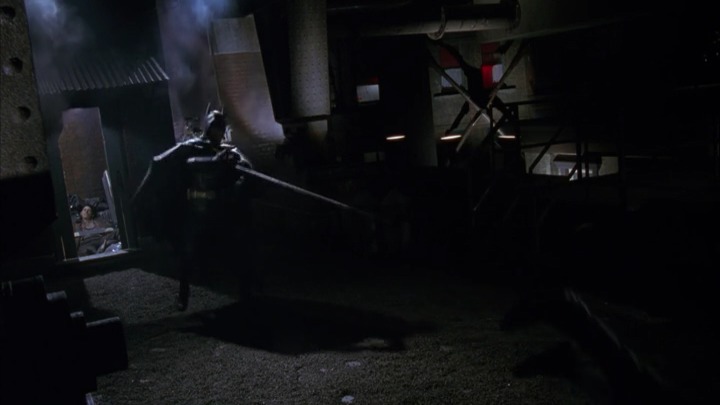
A quick cut to the wire wrapped around his ankle.
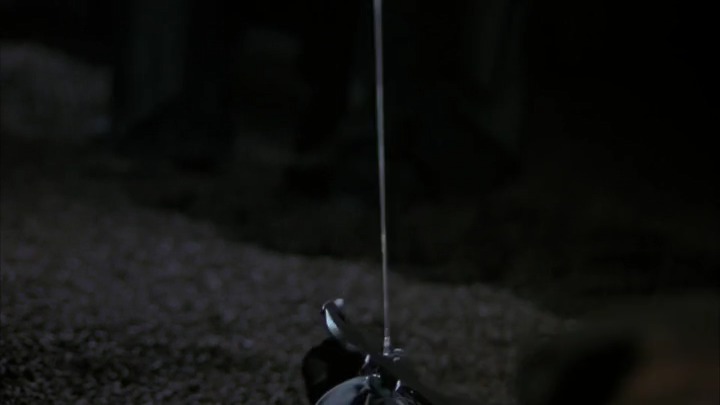
Back to the wider diagonal composition shot from before, but closer to the ground. We’re going to look at this from the point-of-view of the thief, being dragged inexorably towards the waiting figurative maw of The Batman.
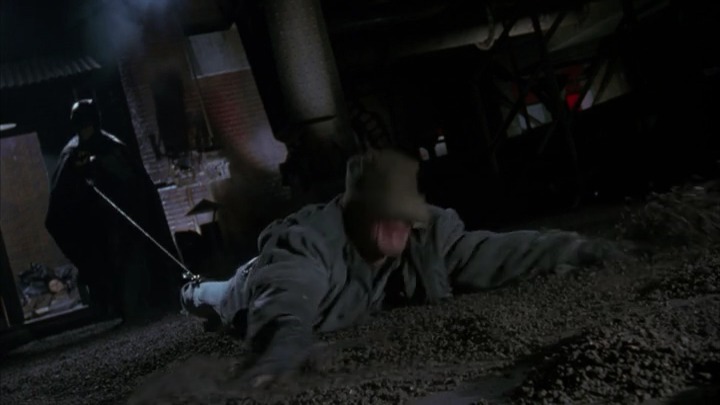
Now, we move to the thief’s head-level, and watch him being pulled right-to-left across the frame. This is classic horror film fare, and with the motion being against the natural flow, as right to left motion implies, we subconsciously know that whatever awaits this man is not good.
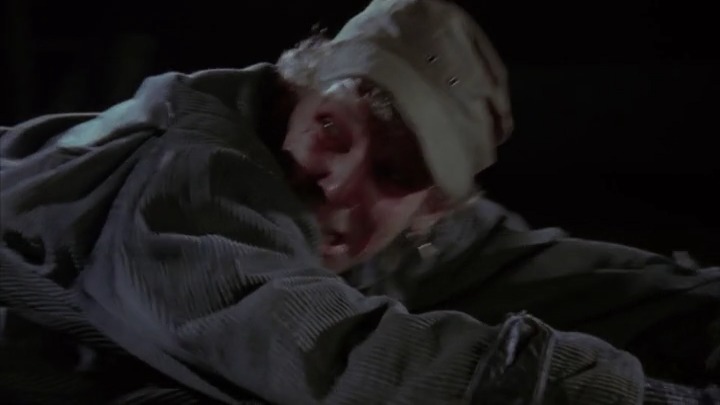
We move to a shot / reverse-shot setup, first showing The Batman’s face clearly for the first time in a canted composition …
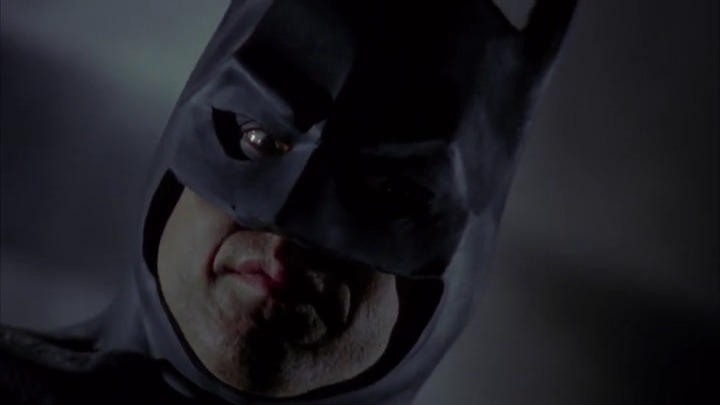
… then the prone thief, powerless on the ground.
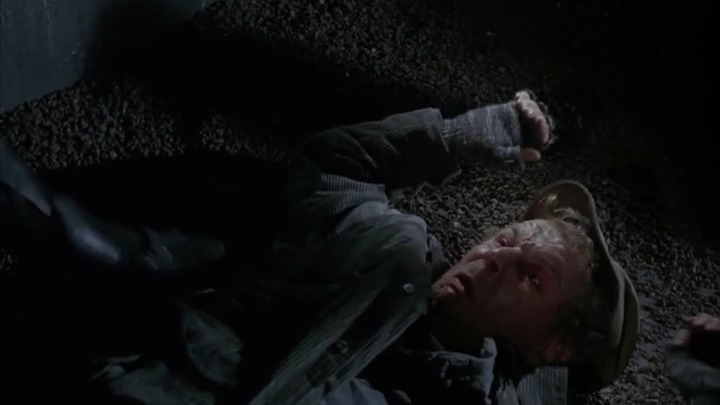
We move to a wide overhead shot, showing the edge of the roof as The Batman drags the thief towards a very nasty-looking drop.
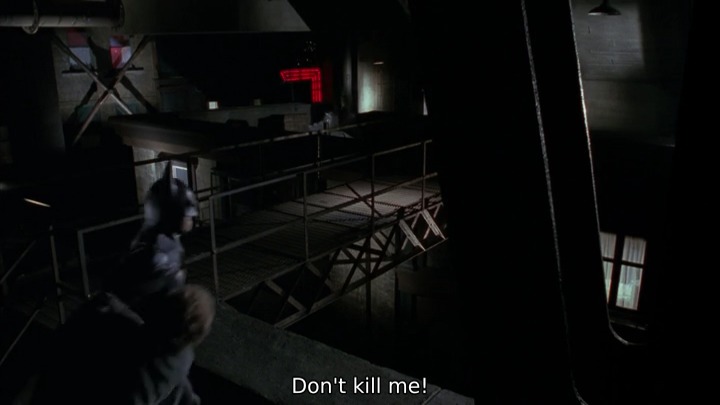
A closer up-angle on The Batman with the thief lifted up in the air, begging for his life. He is only visible as a silhouetted outline.
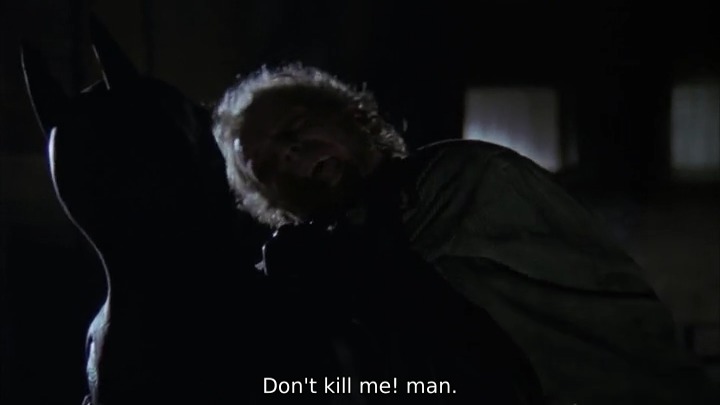
Cut to a low shot of just their feet. The Batman is in control – his feet planted firmly on the edge of the roof – while the thief dangles over …
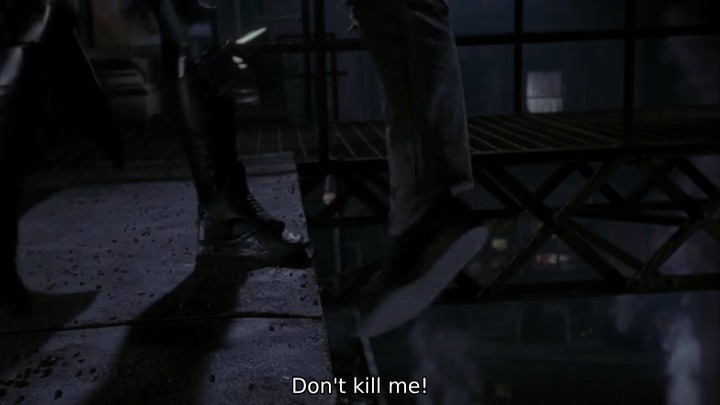
… a very nasty drop. This point-of-view shot is from the thief’s vantage point. The break between the roof and the street is along the equatorial break of the frame.
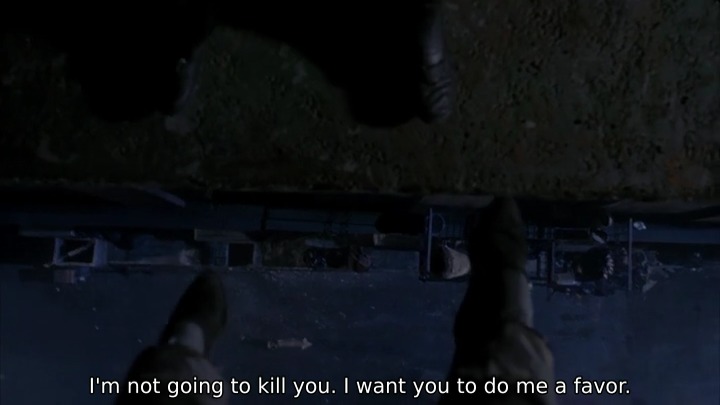
Cut to a shot, much like the feet-level shot, but this time, showing the two figures occupying the thirds of the frame.
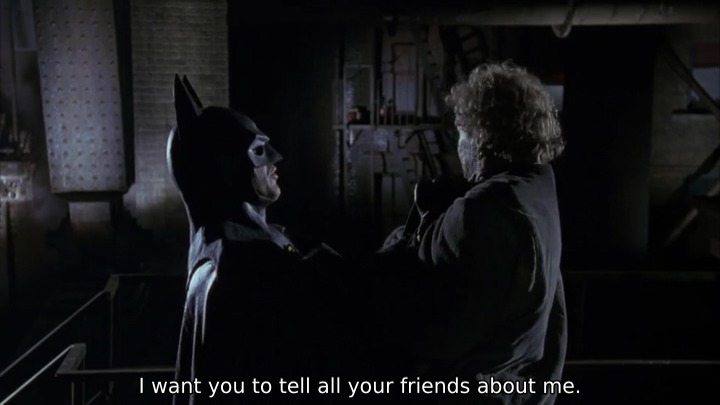
Now, a very subtlely angled shot / reverse-shot setup in the standard over-the-shoulder configuration, setting up the reveal of “I’m Batman”.
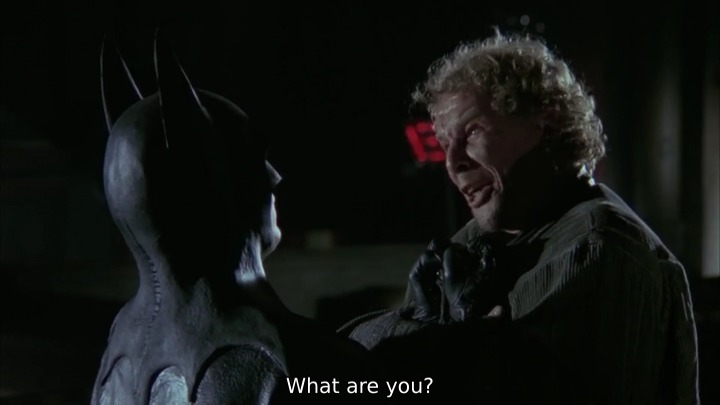

The Batman throws his prey to a safe space, then stands at the edge of the roof from our voyeuristic high vantage point.
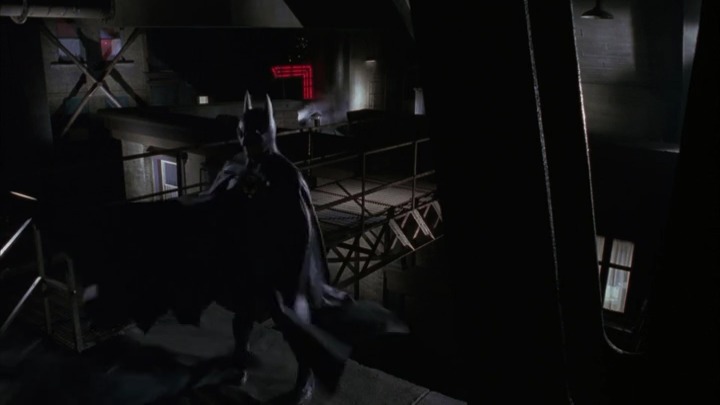
Reverse to a shot of the semi-prone thief on the roof as a reaction shot, looking incredulously at the edge of the roof.
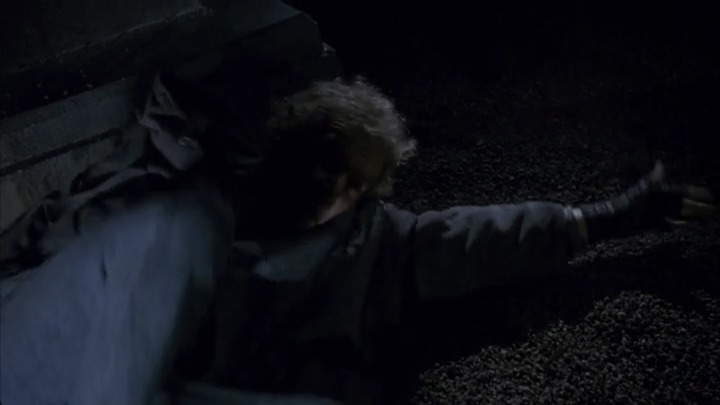
What’s this? The Batman walks off the edge of the roof.
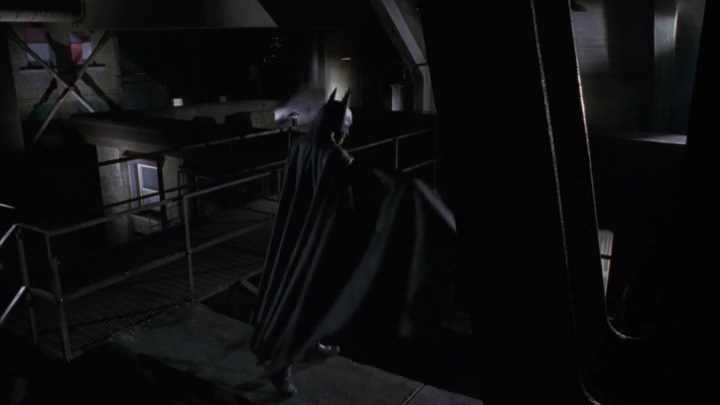
Back to the reverse, with the thief sitting up, wide-eyed.
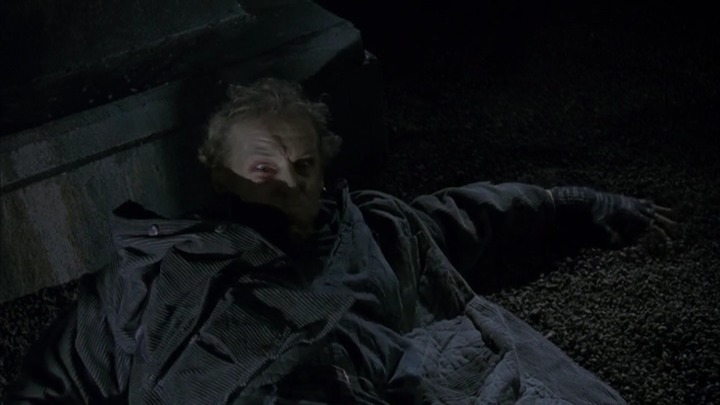
We look from below the roof line up at the thief …
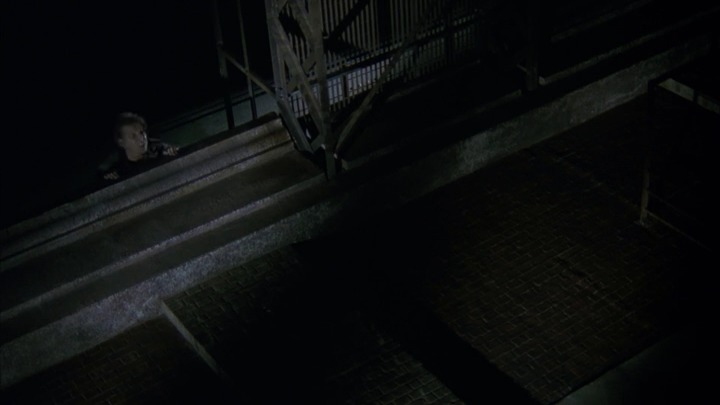
… then reverse to see the canted view of the fog covered street below. The Batman is gone.
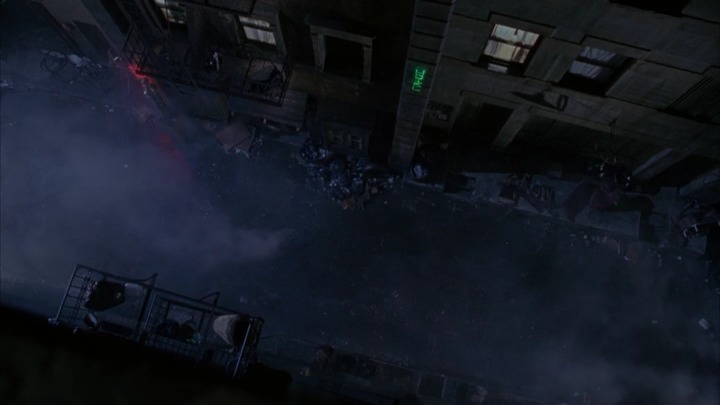
A closer reverse, and we can see the reaction of the thief – this is no ordinary man.
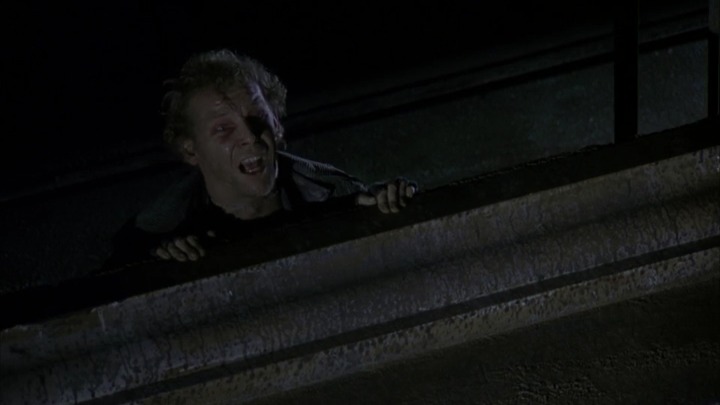
Conclusion and Theme Analysis
The Batman, as a symbol of vigilante justice against a corrupt and crime-laden city, is built up by the use of subtle visual cues and withholding information; the horror that you don’t see is always scarier than the horror that you can see.
All of the visual cues in the first act seem designed to promote unease and confusion, helping us to relate more to the plight of the lost family which figures prominently in it. As we proceed forward through the second part, we’re kept on edge through the use of both claustrophobic and incredibly wide composition. There is also heavy use of canted angles to promote the off-balance nature of the setting.
The third act plays as a simple horror: the monster that cannot be heard or killed, the victim who cannot escape. The Batman has to be a supernatural force, for his “power” is that the mystery of what he may or may not be is feared far more than the threat of impending violence.
As far as the dutch angle (which I refer to as a “cant” pretty consistently), there’s a reason why it is sometimes referred to as a “Batman angle”: from the Adam West campy series through this film, it is used heavily. Not only is it an effective way to fill horizontal space with vertical content in a wide frame, but the disconcerting nature of that compositional technique lends itself to The Batman and his foes. Much as Gilliam has made extensive use of canted shots in his films (Tideland and Fear and Loathing in Las Vegas come to mind), Batman also relies heavily on the technique without over-using it – which is a popular rookie filmmaker mistake.
The AV Club’s Scott Eric Kaufman kindly pointed out to me that the theme of the misleading woman in red – what could be seen as a semi-literal “red herring” – is a repetitive theme. It is a retelling of the Batman origin story to a degree; we have the rich parents, the child forced to watch, the backdrop of the alley. We are expecting the film to open with the all-too-familiar Batman origin, but Burton uses that expectation to make the third-act introduction of The Batman that much more poignant. Virtually every part of the setup creates – then subverts – the expectations of the viewer coming from a knowledge of a larger canon, as well as the expectation of a new viewer to the Batman canon.
It is fitting that the re-introduction of The Batman should be staged as a three-act story ; a figure that much larger-than-life deserves it.
(All images are presented under fair use guidelines – all frame grabs are property of Warner Brothers, The Guber-Peters Company, PolyGram Filmed Entertainment, or any other entities who hold copyright on this film. They are presented for exclusively educational purposes.)